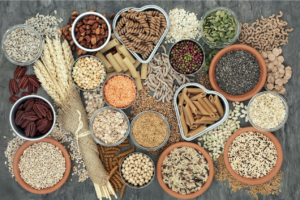So Many Pastas! Nutrition Experts Weigh in on the Options
Avril Rowerdink, RDN, LDN, CES and Anne Till MNutr., RDN, LDN
Pasta and Whole Grains?
Can a family favorite, a quick and easy Pasta meal, fit into a healthy way of eating? We intend to answer this question in this blog and provide you with some “food” for thought, so you can make up your own mind!
We often describe our recommendations for a healthy way of eating as “a high-quality diet” – one that adequately provides the nutrients our bodies require for a healthy metabolism and for wellness. This is a way of eating that includes a high proportion of unprocessed or minimally processed foods – fruits, vegetables, whole grains, beans/legumes, lean proteins, and healthy fats. In this quest to eat a minimally processed, high quality diet, what to do about pasta?
Let’s first ask and evaluate: is there a problem with pasta?
Most pasta is made from refined wheat flour, which means that the wheat used to make the pasta has been stripped of fiber and many valuable vitamins, minerals and antioxidants.
The next problem we face is that an “acceptable” portion of pasta is often at least 1 ½ cups of cooked pasta at home, and in restaurants can be up to a 4 cup serving. Pasta contains starch which is a type of carbohydrate that raises blood sugar. In a 1 ½ cup serving of pasta you will get an estimated 65g of carbohydrate which is the same as eating about 4 slices of bread. If you eat a restaurant serving of 3 cups of pasta (about 135g of carbohydrate), that is about the same as eating about 9 slices of bread.
Because pasta is usually consumed in larger portions, it can significantly raise your blood sugar, stimulating high levels of insulin. Insulin is a hormone that regulates blood sugar, but it is also a storage hormone, and when levels are high it will contribute to fat storage (weight gain) and energy instability. This is particularly problematic for people with insulin resistance, pre-diabetes or diabetes.
Many pasta products are also made with “enriched” flour, which has been stripped of several (at least 17¹!) naturally occurring nutrients and then fortified with only a handful of synthetic nutrients. Because refined grains lack nutrients and fiber, they contribute to a lack of satiety (feeling of fullness and satisfaction after eating). This means that even with the best intentions, it will be hard to stick to having just a small portion of pasta.
Adding to these problems is that foods which typically accompany a traditional pasta meal include buttery garlic bread and often high fat meats, cheese and cream. A dinner size portion of spaghetti with marinara and meatballs at an Italian restaurant contains over 1000 calories from refined carbohydrates and saturated fats, and this doesn’t include the breadsticks and salad (including dressing). Meals like this will trigger a significant metabolic response, and if done regularly can contribute to weight gain and/or health problems.
So, pasta is problematic in part because of how it’s made, but it’s more an issue of how we eat it – how much, with what, and how often.
Consider pasta in the context of whole grain recommendations.
When refined grains entered our food supply in the late 1800’s, as a result of new milling technology, deficiencies of B vitamins became widespread. At that time, fortification of refined grains became a governmental requirement: enter “enriched grains”. Rice is a starchy food just like pasta. So, let’s use rice as an example to compare whole grains with refined grains. The below chart from the Whole Grains Council compares refined (white) rice, unrefined (brown) rice, and enriched white rice. Our best option for health and wellness is to eat whole grains in their whole form, such as oats, corn, and brown rice, barley, farro, and quinoa, as these naturally have the highest nutritional value.¹ Unfortunately pasta is not a naturally occurring wholegrain, and while wheat is used to make pasta – it is usually from white or enriched wheat. So, it is unlikely to serve our nutritional goals.
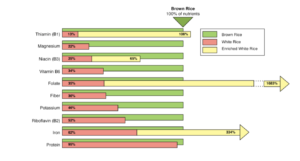
Consider pasta in the context of your health goals.
A diet high in processed foods (typically made with refined grains) contributes to inconsistent energy levels and difficulty managing appetite throughout the day. This way of eating can trigger unintentional overeating and therefore weight gain. High refined grain intake is also linked with insulin resistance (the precursor to diabetes and an influencer of heart disease), other metabolic dysfunctions, and weight gain. On the other hand, because whole grains have more B vitamins, vitamin E, minerals, protein, healthy fat and fiber content (see below image from Harvard School of Public Health), consumption of whole grains is linked with a reduced risk of heart disease, stroke, cancer, diabetes, obesity¹, mortality, and diverticular disease.²
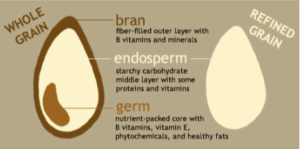
Pasta solutions
So, what do we do about pasta and the classic comfort meals made with it? Do we need to avoid it? Looking at alternatives, a first thought might be wheat pasta. This option provides more micronutrient punch and more fiber, but contains a similar amount of total carbohydrates and remains a processed (albeit less processed) food item. It’s a decent second best to traditional pasta and offers a source of whole grains, but the appropriate portion size remains small due to the carbohydrate density.
Next up, there are pastas made with flours other than wheat, such as legume flours (typically chickpea, lentil, and soybean) and brown rice flour. There are also pastas marketed as made from gluten free flours (typically gluten free pastas are made from corn and/or rice flour, but really any of the legume pastas do not contain gluten either). And then there are vegetables in the shapes of pasta, such as zucchini noodles (“zoodles”), spaghetti squash, and palmheart noodles. Let’s compare by the numbers in the table and charts below:

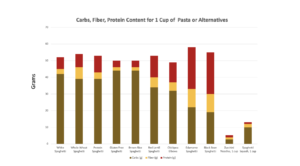
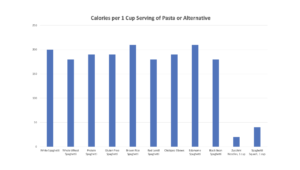
Key takeaways:
- There are many health benefits associated with the intake of whole grains, whereas there are health risks associated with the intake of refined grains.
- Ultimately, we should aim to eat whole grains daily, in their whole form, such as oats, corn, brown rice, farro, and barley. February is American Heart month, so this is a great reminder to focus on the MyPlate guideline to make at least “half your grains whole”!
- Several of the pastas made with flours other than wheat are much higher in protein and fiber than traditional white pasta. These make for a great, well-balanced alternative: add vegetables (such as a side salad or diced vegetables in the pasta sauce) and you have a complete meal.
- When aiming to eat a minimally processed, high quality, lower calorie diet, your best bet are vegetable “noodles”, such as zoodles and spaghetti squash. They are high in nutrients and low in calories, and as such they allow for room on your plate for a small serving of truly whole grains, such as quinoa or wild rice. For a complete meal, add a protein source like lean ground turkey, shrimp, or crumbled tempeh.
- Or, simply enjoy a small portion of your favorite traditional pasta along with a lean protein source and a large side of vegetables to fill you up, and look to include whole grains elsewhere in your day.
Click here for recipes using whole grains.
Here are some links to vegetable pasta recipes:
Zoodle
Spaghetti Squash
References and Resources:
1. https://wholegrainscouncil.org/
2. https://www.hsph.harvard.edu/nutritionsource/what-should-you-eat/whole-grains/
3. Healthline: Is Pasta Healthy or Unhealthy?
If you enjoyed and benefited from this information, please like and share it.
Yours in health and wellness,
Avril Rowerdink, RDN, LDN, CES and Anne Till MNutr., RDN, LDN
Our Dietitians/Nutritionists are here to help you and our office is open. Most major health
insurance companies are now covering telehealth visits, usually at no cost to you. Our office will
verify your benefits for you – both for existing patients and new patients. What you choose to
eat is an essential part of managing your health and wellness. Let us help you to get on track
and find a suitable individualized approach to help you to stay healthy.
Click here to contact us for more information.
Call Us Today: 919-990-1130






